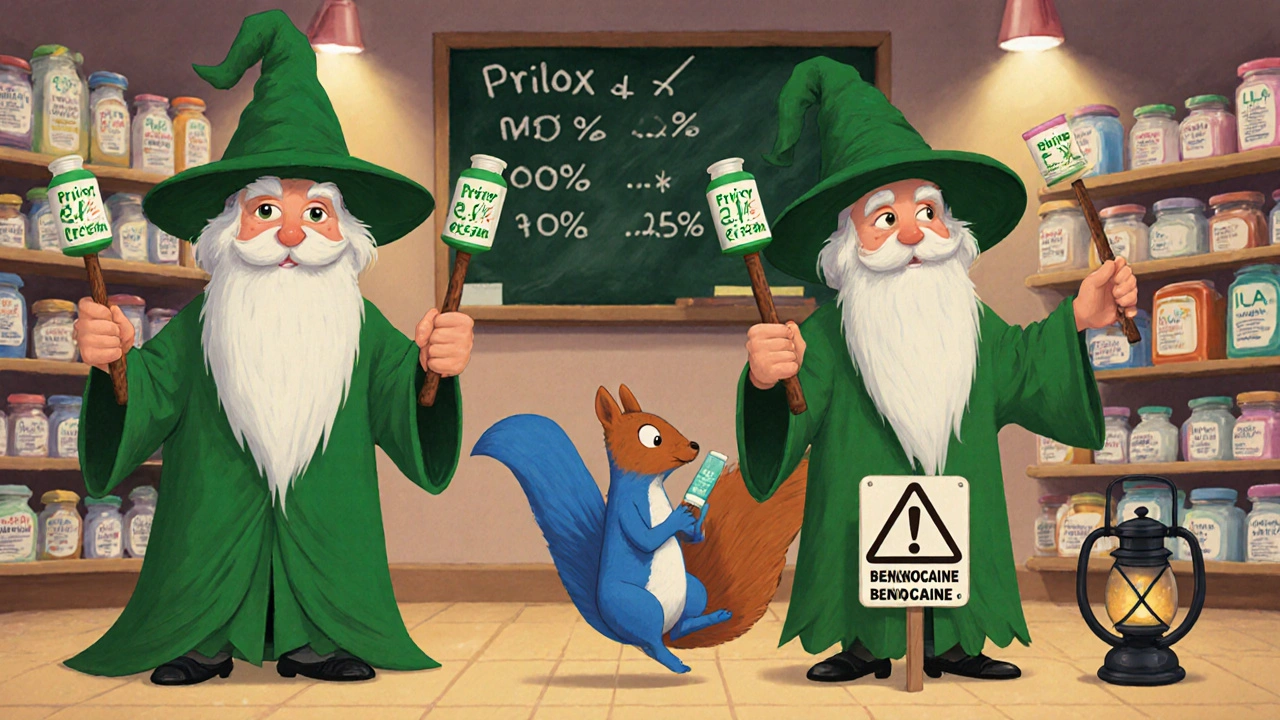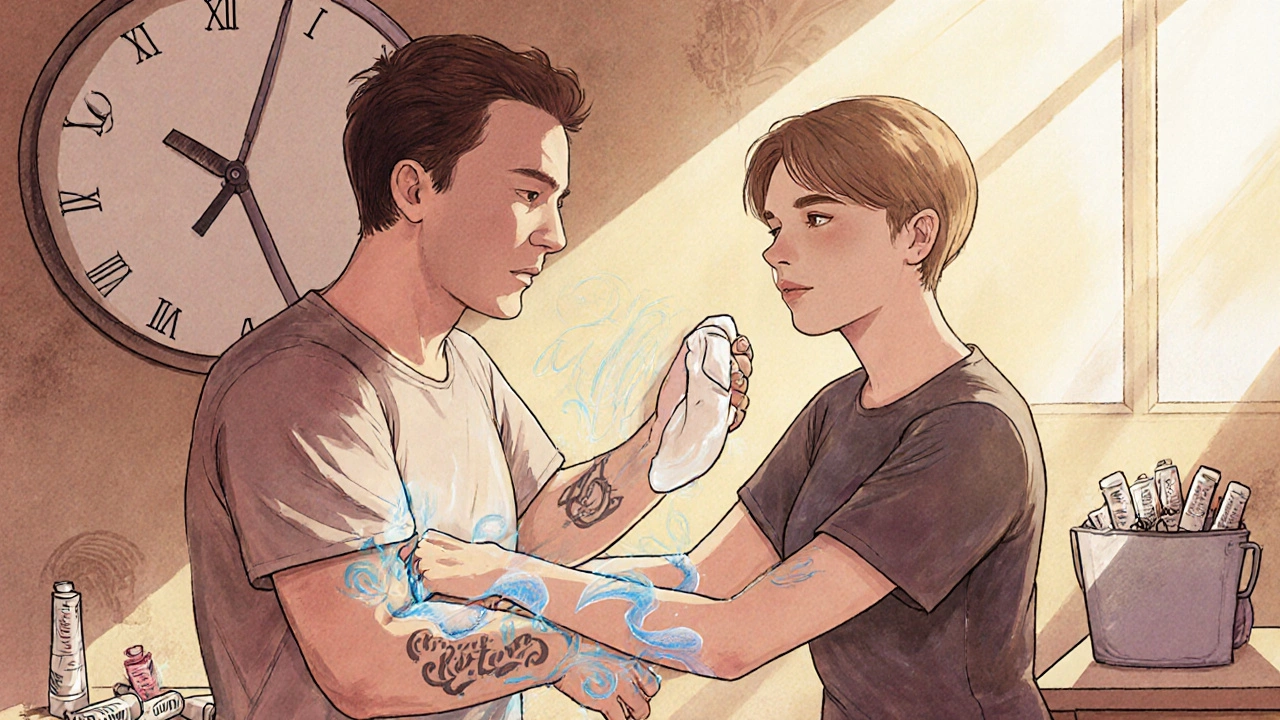Prilox Cream is a topical anesthetic used to numb skin before minor procedures like needle insertions, laser treatments, or minor skin surgeries. It combines two local anesthetics-lidocaine and prilocaine-in a 1:1 ratio. But is it the best option? Many people wonder if other creams, gels, or patches might work better, cost less, or cause fewer side effects. This guide breaks down how Prilox Cream stacks up against the most common alternatives, so you know exactly what to choose based on your needs.
What’s in Prilox Cream?
Prilox Cream contains 2.5% lidocaine and 2.5% prilocaine. That’s 5% total anesthetic concentration. Both ingredients block nerve signals in the skin, stopping pain before it starts. The cream is applied under an occlusive dressing (like a bandage) for about 1 hour before the procedure. It’s FDA-approved and widely used in clinics across Australia, the U.S., and Europe.
Unlike single-agent creams, the combination of lidocaine and prilocaine works faster and deeper. Lidocaine kicks in quickly, while prilocaine lasts longer. Together, they penetrate the skin better than either one alone. Studies show Prilox Cream can numb skin up to 5 mm deep-enough for most minor procedures.
Top Alternatives to Prilox Cream
There are several other topical anesthetics on the market. Here are the most common ones you’ll find in pharmacies or prescribed by doctors.
Lidocaine Alone (5% Cream or Gel)
Lidocaine is the most common single-agent topical anesthetic. You can buy 5% lidocaine cream over the counter in many countries, including Australia. It’s cheaper than Prilox Cream and works well for surface numbing.
But here’s the catch: lidocaine alone doesn’t penetrate as deeply. If you’re getting a tattoo, a mole removal, or a laser hair treatment, you might still feel some discomfort. Clinical trials show lidocaine-only creams numb skin to about 2-3 mm depth, while Prilox reaches 4-5 mm.
Also, lidocaine can cause more skin irritation in sensitive people. Redness, itching, or burning at the application site is more common than with Prilox.
Prilocaine Alone (4% or 5% Cream)
Prilocaine alone is less common than lidocaine. It’s used in some medical settings, especially for patients allergic to ester-type anesthetics like benzocaine. But it’s slower to work.
Prilocaine needs 60-90 minutes to reach full effect, compared to Prilox’s 60 minutes. It also doesn’t penetrate as deeply on its own. Most doctors don’t recommend prilocaine-only creams for routine use because they’re less effective than the combo.
EMLA Cream (Same as Prilox)
EMLA Cream is the original brand name for the lidocaine-prilocaine combo. It’s made by AstraZeneca and has the same formula as Prilox: 2.5% lidocaine + 2.5% prilocaine. In many countries, including Australia, EMLA is the branded version, while Prilox is the generic.
They’re identical in effectiveness, safety, and application. The only difference? Price. EMLA usually costs 2-3 times more than generic Prilox. If you’re paying out-of-pocket, Prilox is the smarter buy.
LMX4 and LMX5 (Lidocaine 4% and 5%)
LMX4 and LMX5 are brand-name lidocaine gels. LMX4 has 4% lidocaine, LMX5 has 5%. They’re designed to be applied without occlusion-no bandage needed. That makes them more convenient.
But convenience comes at a cost. Without a dressing, the cream evaporates faster and doesn’t absorb as deeply. A 2023 study in the Australian Journal of Dermatology found LMX5 numbed skin to only 2.8 mm depth, compared to 4.7 mm with Prilox under occlusion.
LMX products are good for quick procedures like IV starts or blood draws. Not ideal for tattoos or longer sessions.
Benzocaine Creams (20%)
Benzocaine is found in many OTC numbing sprays and creams-think oral gels for teething or sunburn relief. But it’s not recommended for skin numbing before medical procedures.
Benzocaine has a higher risk of causing methemoglobinemia, a rare but serious blood condition that reduces oxygen delivery. The FDA has warned against using benzocaine in children under 2, and many clinics avoid it entirely for adults too.
It also wears off fast and doesn’t penetrate deeply. Avoid benzocaine creams if you’re preparing for anything beyond minor surface irritation.
Numby-Pumbby, NumbSkin, and Other OTC Brands
There are dozens of OTC numbing creams sold online or in pharmacies under names like Numby-Pumbby, NumbSkin, or Sensi-Cool. Many claim to be “stronger than EMLA” or “doctors’ secret.”
Here’s the truth: most of these contain low-dose lidocaine (1-3%), sometimes mixed with menthol or camphor for a cooling sensation. That feels nice, but it doesn’t add real numbing power. Some even contain unapproved ingredients or hidden steroids.
Always check the active ingredients. If it doesn’t list lidocaine or prilocaine by name and percentage, don’t trust it. Stick to FDA-approved or TGA-approved products.
How Do They Compare? A Quick Table
| Product | Active Ingredients | Time to Effect | Depth of Numbing | Cost (AUD, 30g tube) | Best For |
|---|---|---|---|---|---|
| Prilox Cream Generic lidocaine-prilocaine cream, 2.5% each | 2.5% Lidocaine + 2.5% Prilocaine | 60 minutes | 4-5 mm | $25-$35 | Tattoos, laser, minor surgery |
| EMLA Cream Brand-name lidocaine-prilocaine, same formula as Prilox | 2.5% Lidocaine + 2.5% Prilocaine | 60 minutes | 4-5 mm | $70-$90 | Same as Prilox, if insurance covers it |
| 5% Lidocaine Cream Single-agent, OTC option | 5% Lidocaine | 60-90 minutes | 2-3 mm | $15-$20 | Minor surface pain, sunburn |
| LMX5 Lidocaine 5% gel, no occlusion needed | 5% Lidocaine | 30-45 minutes | 2.5-3 mm | $30-$40 | IV starts, blood tests |
| Benzocaine 20% Cream Common in OTC products | 20% Benzocaine | 15-20 minutes | 1-2 mm | $10-$18 | Not recommended for medical use |

When to Choose Prilox Cream
Prilox Cream is your best bet if you need:
- Deep numbing (4-5 mm) for procedures like laser hair removal, tattooing, or skin biopsies
- Long-lasting effect (up to 2-3 hours after removal)
- Reliable performance backed by clinical trials
- A cost-effective alternative to EMLA without sacrificing quality
It’s especially popular in Brisbane clinics for laser treatments and pediatric vaccinations. Nurses here often use it on kids before shots because it’s gentle and effective.
When to Skip Prilox Cream
Prilox isn’t always the right choice. Avoid it if:
- You need a quick numbing solution-like for a blood draw. Use LMX5 instead.
- You’re allergic to amide-type anesthetics (lidocaine or prilocaine). Talk to your doctor about alternatives like tetracaine.
- You’re pregnant or breastfeeding. While Prilox is generally considered safe, there’s limited data. Always check with your OB-GYN.
- You have liver or kidney disease. Prilocaine is metabolized by the liver and excreted by the kidneys. Your doctor may adjust the dose or suggest another option.
Common Mistakes People Make
Even when you pick the right cream, mistakes can ruin the results.
- Not using an occlusive dressing. Prilox needs to be covered with plastic wrap or a special patch. Without it, the cream dries out and doesn’t absorb.
- Applying too little. Use a thick layer-about the size of a pea for a 2 cm area. Thin layers won’t work.
- Waiting too little time. Don’t rush it. 60 minutes is the minimum. For tattoos or large areas, leave it on for 90 minutes.
- Using expired cream. Once opened, Prilox lasts 6 months. Check the expiration date and discard if it looks grainy or smells odd.

What Do Real Users Say?
In online forums and clinic feedback, users consistently rate Prilox Cream higher than single-agent creams. One tattoo artist in Melbourne told us: “I’ve tried every cream. Prilox is the only one that makes clients say ‘I didn’t feel a thing’ during a 3-hour session.”
Another parent in Sydney shared: “My daughter’s vaccination was so much easier with Prilox. She didn’t cry once. We’ve used it three times now.”
But some users complain about the mess. The cream is thick and greasy. It stains clothes. That’s why some prefer LMX5 gel-it’s cleaner, even if less effective.
Final Verdict
Prilox Cream is the most effective, affordable, and widely trusted topical anesthetic for procedures requiring deep skin numbing. It beats single-agent creams like lidocaine-only or benzocaine in both depth and reliability. EMLA is the same product at triple the price. LMX5 is faster and cleaner but doesn’t go as deep.
If you’re getting a tattoo, laser treatment, or minor surgery-go with Prilox. Apply it thick, cover it, wait an hour, and you’ll feel nothing. Skip the gimmicky OTC brands. Stick with what’s proven.
Is Prilox Cream the same as EMLA?
Yes, Prilox Cream and EMLA Cream have the exact same active ingredients: 2.5% lidocaine and 2.5% prilocaine. The only difference is the brand name and price. EMLA is the original brand and costs much more. Prilox is the generic version and works just as well.
Can I buy Prilox Cream over the counter in Australia?
No, Prilox Cream is a prescription-only medicine in Australia. You need a doctor’s prescription to get it from a pharmacy. Some online pharmacies sell it without a prescription, but that’s illegal and risky. Always get it through a licensed provider.
How long does Prilox Cream last after application?
The numbing effect starts after about 60 minutes and lasts up to 2-3 hours after removing the cream. For best results, keep it covered with plastic wrap or an occlusive dressing during that time. The numbing fades gradually, not suddenly.
Is Prilox Cream safe for children?
Yes, Prilox Cream is safe for children when used as directed. It’s commonly used before vaccinations and minor skin procedures. However, the amount used should be based on the child’s weight and skin area. Always follow your doctor’s instructions.
Can I use Prilox Cream for tattoos?
Many tattoo artists recommend Prilox Cream for large or sensitive areas. Apply a thick layer 60-90 minutes before the session, cover with plastic wrap, and wipe off before starting. It won’t eliminate all pain, but it reduces it significantly-especially during long sessions.
What are the side effects of Prilox Cream?
Side effects are rare but can include mild redness, swelling, or itching at the application site. In very rare cases, it can cause paleness or bluish skin due to methemoglobinemia, especially with large doses or in people with certain genetic conditions. If you feel dizzy, short of breath, or your skin turns blue, seek medical help immediately.
What to Do Next
If you’re considering Prilox Cream for a procedure, talk to your doctor or dermatologist. Ask if it’s right for your skin type and procedure. Bring a list of alternatives you’ve researched-this shows you’re informed and helps them make a better recommendation.
If you’re getting a tattoo, ask your artist if they use Prilox Cream or recommend it. Many studios stock it or can direct you to a pharmacy that carries it.
Don’t rely on random online reviews or unbranded creams. Stick with trusted brands, follow instructions, and give yourself enough time. The right numbing cream can make a painful procedure feel almost painless.


Comments
Scott Dill
Prilox is the real deal-used it before my sleeve tattoo and honestly, I could’ve fallen asleep. LMX5? Nah, that’s for quick blood draws, not 4-hour sessions. Save your cash and go generic.
October 30, 2025 at 06:17
Erin Corcoran
OMG YES!!! 😍 I’ve tried EVERYTHING-EMLA, LMX, even that sketchy ‘NumbSkin’ off Amazon (big mistake 😅). Prilox is the only one that actually WORKS without making my skin look like a tomato. Pro tip: slap on a thick layer + saran wrap = magic. Also, it’s half the price of EMLA. Why pay more??
October 30, 2025 at 23:05
Kathy Pilkinton
People keep saying ‘Prilox is just EMLA’ like that’s some deep insight. Wow. Groundbreaking. Next you’ll tell me Coca-Cola and Pepsi are both soda. At least EMLA has brand trust. Prilox? Could be anything in that tube. I’ve seen generic creams with weird additives. Don’t be a lab rat.
October 31, 2025 at 02:07
shivam mishra
As a dermatology tech in Delhi, I’ve used both Prilox and EMLA daily. The formulation is identical-same batch numbers in the packaging if you check closely. EMLA’s price is pure brand tax. I’ve seen patients cry because EMLA cost $90 and they had to pay out of pocket. Prilox? $28. Same result. Also, avoid benzocaine like the plague-methemoglobinemia isn’t a myth, it’s a hospital visit.
October 31, 2025 at 18:26
Holly Dorger
Just wanted to say thanks for this guide. I got my first tattoo last week and used Prilox like you said-thick layer, plastic wrap, 90 mins. Didn’t feel a thing. My artist was impressed. Also, the greasy mess? Totally worth it. I stained my favorite hoodie though… whoops. 😅
November 2, 2025 at 03:07
John Kane
Man, this is the kind of post that makes Reddit worth it. I’m from Texas, my cousin’s from Mumbai, and we both use Prilox for her kid’s shots and my laser hair removal-same product, same results. That’s the beauty of science, not branding. EMLA’s just the same cream in fancier packaging with a fancy label. I’ve even bought it in Australia and the U.S.-same formula, different price tags. Don’t let marketing fool you. Also, side note: if your cream looks grainy or smells like old cheese, chuck it. I once used expired stuff and my arm felt like it was on fire. Lesson learned. Always check the expiry. And yes, kids can use it safely-my niece got her DTaP shot with Prilox and didn’t even flinch. Best $30 I’ve ever spent.
November 3, 2025 at 10:40
Mansi Gupta
Thank you for the detailed comparison. In India, access to branded products like EMLA is limited and expensive. Generic Prilox is widely available through licensed pharmacies with prescription. The clinical data supports its efficacy, and local dermatologists recommend it for laser treatments. I have used it for my patients with sensitive skin, and the reaction profile is comparable to EMLA. One must ensure proper occlusion and adequate application time. Avoiding unregulated online products is critical, as many contain undisclosed ingredients that may cause allergic reactions or systemic toxicity.
November 4, 2025 at 04:28
Mike Gordon
Prilox vs EMLA? Same thing. End of story. But let me tell you about the real villain here: the pharmacy that charges $80 for EMLA and pretends it’s a miracle cure. I’ve seen this in three states. It’s not just overpriced-it’s unethical. And don’t get me started on those ‘tattoo numbing gels’ with menthol that burn more than the needle. If it says ‘natural’ and doesn’t list lidocaine/prilocaine percentages? Run. I’ve had patients show up with chemical burns from those. Stick to the science. Not the sales pitch.
November 4, 2025 at 11:52
Amanda Nicolson
Okay, I’m not a doctor, but I’ve had 12 tattoos, 3 laser sessions, and a mole removed-all with Prilox. And let me tell you, the difference between this and just using lidocaine cream? It’s like comparing a Ferrari to a bicycle. You feel the pressure, the vibration, the scratch-but not the pain. Not one tear. Not one flinch. I even used it on my foot for a big piece and slept through half of it. The greasy mess? Yeah, I had to wash my sheets. Worth it. The 60-minute wait? I watched three episodes of The Office. No regrets. The only thing I’d add? Use gloves when applying. Otherwise you’ll numb your fingers too… and then you can’t text for an hour. Oops.
November 4, 2025 at 17:11
Arrieta Larsen
Prilox is perfect for tattoos. I’ve used it on my clients for years. But don’t forget: if you’re pregnant or have liver issues, talk to your doctor first. Prilocaine metabolism matters. I’ve seen too many people assume ‘it’s just cream’ and ignore warnings. Don’t be that person.
November 5, 2025 at 18:01
Write a comment